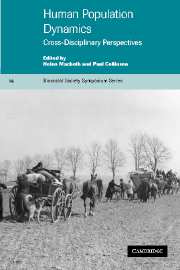Book contents
- Frontmatter
- Contents
- List of contributors
- Foreword by G.A. Harrison
- Preface
- 1 Introduction: the framework of studying human population dynamics
- 2 Demographic perspectives on human population dynamics
- 3 The growing concentration of world population from 1950 to 2050
- 4 Population, community and society in peasant societies
- 5 From genetic variation to population dynamics: insights into the biological understanding of humans
- 6 Social institutions and demographic regimes in non-industrial societies: a comparative approach
- 7 The dynamics of child survival
- 8 Genetic structure of south Indian caste populations: a confluence of biology and culture
- 9 Fertility, mortality and migration transitions in association with socioeconomic modernisation among highland minority populations in Southeast Asia
- 10 Ecology, homeostasis and survival in human population dynamics
- Glossary
- Index
- References
7 - The dynamics of child survival
Published online by Cambridge University Press: 11 August 2009
- Frontmatter
- Contents
- List of contributors
- Foreword by G.A. Harrison
- Preface
- 1 Introduction: the framework of studying human population dynamics
- 2 Demographic perspectives on human population dynamics
- 3 The growing concentration of world population from 1950 to 2050
- 4 Population, community and society in peasant societies
- 5 From genetic variation to population dynamics: insights into the biological understanding of humans
- 6 Social institutions and demographic regimes in non-industrial societies: a comparative approach
- 7 The dynamics of child survival
- 8 Genetic structure of south Indian caste populations: a confluence of biology and culture
- 9 Fertility, mortality and migration transitions in association with socioeconomic modernisation among highland minority populations in Southeast Asia
- 10 Ecology, homeostasis and survival in human population dynamics
- Glossary
- Index
- References
Summary
Introduction
Changes in child survival rates are very significant in the dynamics of human populations, and mortality is an important variable in studies of demography, genetics and anthropology. Furthermore, rates of child survival provide an important indication of the general biological welfare of a population.
Children are a particularly vulnerable group, both physically and socially, within human populations (Caldwell 1996). This vulnerability is reflected in mortality rates, which are highest during infancy, decrease from 1 to 4 years and reach a minimum from 5 to 9 years of age. The physical vulnerability of children stems from an immature immune system, rendering them particularly susceptible to infectious diseases. This is coupled with a high energy and nutrient requirement relative to body weight. These intakes are required to fuel the high energy demands of the human brain, as well as for somatic growth and development. One of the most critical periods for child survival is the weaning period, typically from six months onwards, when infants make the transition from dependence on mother's milk to reliance on the local diet (Martorell 1995). Children are also socially vulnerable, being entirely dependent on adult carers for the first year of life and remaining highly dependent up to the age of five. This social dependence means that children are susceptible to conscious or unconscious neglect (Caldwell 1996).
This chapter examines the sociocultural and biological correlates of child survival, contrasting populations with low and high survival rates.
- Type
- Chapter
- Information
- Human Population DynamicsCross-Disciplinary Perspectives, pp. 124 - 140Publisher: Cambridge University PressPrint publication year: 2002
References
- 11
- Cited by



